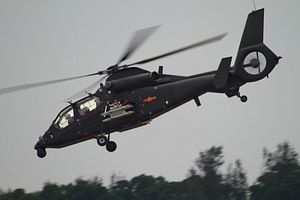The export variant of the Harbin WZ-19 reconnaissance/attack helicopter, dubbed Z-19E, conducted its maiden flight on May 18 in Harbin in northeast China’s Heilongjiang Province, Xinhua News Agency reports.
The Z-19E, developed by AVIC Harbin Aircraft Industry, is a narrow-body, twin-seat tandem helicopter based on the Harbin WZ-9 medium multipurpose utility helicopter, which in turn is a licensed variant of the French Eurocopter AS265 Dauphin.
The helicopter has been specifically developed for the “international military trade market,” Xinhua states. “It is also the country’s first export-oriented helicopter made specifically for attack purposes.”
Powered by two WZ-8C turboshaft engines, the helicopter can achieve a top speed of up to 280 kilometers and has a maximum range of 700 kilometers. The Z-19E has a maximum take-off weight of 4,500 kilograms.
“The Z-19E is mainly intended to attack tanks, armed vehicles, defense works, and other targets on the ground,” Xinhua notes. “It can provide direct fire support to ground troops, attack helicopters and other low-altitude targets, fly at a very low altitude and fly as part of a convoy of helicopters.”
To that purpose, the helicopter can be armed with up to eight HJ-8s, an anti-tank guided missile (ATGM), or the HJ-10, an anti-tank missile purportedly the Chinese equivalent to the U.S.-made AGM-114 Hellfire air-to-surface missile. The helicopter is also equipped with a 23 millimeter cannon.
Against aerial targets, the Z-19E can also be fitted with up to eight TY-90 air-to-air missiles. The helicopter is also capable of carrying a number of Chinese-made anti-ship missiles, although there are no indication that the domestic version of the aircraft has been inducted by the People’s Liberation Army Navy so far.
“It is able to be deployed for battlefield support and a variety of other missions in a complicated battlefield environment during day and night,” Li Shengwei, deputy chief designer at AVIC Harbin Aircraft Industry, was quoted as saying.
The first international customer of the Z-19E could be Pakistan, which has been evaluating the WZ-19, along with the Chengdu Aircraft Industry Group’s Z-10 helicopter gunship, since 2015. A number of Z-10 attack helicopters are purportedly already serving with the 35th “Mustangs” Squadron of the Pakistan Army Aviation Corps.
Overall, Pakistan has been satisfied with the Z-10 except for the underperformance of the two under-powered WZ-9 turboshaft engines, which allegedly have prevented the Z-10 from carrying its maximum weapons payload, including up to 16 HJ-10 anti-tank missiles. China, in corporation with a European partner, has been working on a more powerful engine, the WZ-16. The engine, however, has not entered serial production yet.
The domestic variant of the helicopter was first inducted into the People’s Liberation Army and People’s Liberation Army Air Force in 2012. There are currently around 80 WZ-19 reconnaissance/attack helicopters operating with the two services.
































